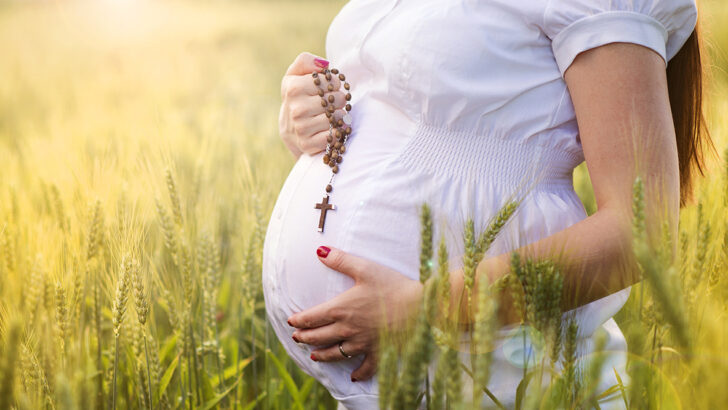At some point in the next 20 or so years, there will be more deaths than births in Ireland, and from there, things are only going to get much worse. There is one big reason for this; we are no longer having enough babies. We have transformed in very little time from a country famous for its big families, to one where families will be very small indeed.
One cause of this transformation is the sharp decline of religious practice. Secular Ireland will need religious people more than it ever believed because religious people are more highly motivated to get married and have children than their secular counterparts. A country that needs more babies also needs more religion, for reasons to be explained more fully further on.
The number of children a couple must have to replace themselves is 2.1. Without immigration, population will decline if a country’s fertility rate drops below this figure.
Our fertility rate fell a little below replacement level in the 1990s, but in the last few years it has been falling very fast indeed. Currently it sits at 1.5 and the Central Statistics Office (CSO) says it will fall to 1.3 in the next few years. A tad optimistically, in my opinion, it believes it will stabilise there, but in other countries, the fertility rate is falling faster than anyone predicted.
If a country’s fertility rate stays at 1.3, its population will be cut in half in just 50 or 60 years, unless there is very high immigration.
The other thing that is going to happen is that there will be far more retired people in the not-too-distant future.
Projecting
Last year, the CSO published a report projecting Ireland’s population to the year 2057. It assumed low, medium and high immigration, and low fertility rates. Under every scenario the number of retirees aged 65 and over is going to grow enormously. In 2022, it stood at 781,000 people. By mid-century this will have grown to almost 2 million. The percentage of people in this age group will grow from 15pc now, to around 30pc by mid-century.
Societies are not supposed to have far more old people than children. Who will look after the elderly if there any not enough young people?”
Meanwhile, the number of young people will dwindle in both absolute and percentage terms. Those over 65 will outnumber children aged 0-14 by over one million. Currently children in this age bracket still comfortably outnumber the retired.
Never in history have we seen anything like this. Societies are not supposed to have far more old people than children. Who will look after the elderly if there any not enough young people? How will we pay for our health and pension systems? What will happen to youthful creativity and energy? What does a society look like when there are few children and very small families?
Not so long ago, it was common for a couple to have four children, and now two is much more common. The reason the fertility level is less than two, at 1.5, is because a growing number of people aren’t having any children or all, or just one.
This very sharp fall in fertility is happening all over the world. Two-thirds of people now live in countries with below replacement fertility. China is well below 2.1, and even India has dropped below this level. The main part of the world with well above replacement level fertility is sub-Saharan Africa.
Immigration
Immigration will only solve the problem of an ageing population somewhat. The number and percentage of retired people is going to explode no matter what (I will be one of them), and eventually immigrants also age and the number of children they have also declines. Additionally, in the future, there will be immense competition between countries for immigrants and we might not get our ‘fair’ share.
A big part of the reason for the fall in fertility rates is rising prosperity. As societies become wealthier, they have smaller families. But in the end, this is self-defeating, because prosperity depends on a minimum number of working age people compared with pensioners.
There is, however, a group of people without our societies that is bucking the trend, and that is the religious. Religious people, on average, have more children than their secular counterparts. In the Unites States, for example, those who attend religious services regularly have on average a little over two children each, while those who never or rarely go have about 1.4.
The Iona Institute (which I run) has just come out with a new report called: ‘Religion, Marriage and Fertility: Shall the Religious Inherit Ireland?’
We are going to very badly need couples who are more highly motivated than the average to marry and have children, and in general those people will be religious”
It draws attention to the fact that those who practice religion are the most likely to marry, stay married, and have children.
As the decades pass, and the country ages, family size falls and childlessness grows, we are going to very badly need couples who are more highly motivated than the average to marry and have children, and in general those people will be religious.
Disparaged
Religion is constantly disparaged here in Ireland, and in most of the Western world. Its intolerant and authoritarian side is constantly highlighted. But religious practice also promotes behaviour that is extremely beneficial to society, and this is constantly overlooked or taken for granted.
Those who practice religion, and in Ireland that still overwhelmingly means Christianity, have better mental and physical health than the average, are less likely to abuse drugs or alcohol, are less likely to commit crime, give more time and money to charity, and above all in the context of what we are discussing here are more likely to marry, stay married and have children.
This is an incredibly important cohort of people, and its importance is only going to grow over time as society ages.
In fact, it is possible that over time, the religious share of the population will grow again. If religious people have more children and become better at keeping their children ‘within the fold’, this must happen as the decades pass. The process could accelerate. As secular people look at our ageing population, a sub-set of them might become attracted to pro-family religions like Christianity again as an antidote.
We are in an age of religious decline. But that decline is helping to trigger an overall demographic decline which will turn in due course into a full-blown crisis. The pro-social benefits of religion will be needed more badly than ever. Secular societies, it is turning out, need religious people very badly, because they are the ones who will be having the most children. The formula is very simple; no children, no society. To turn around the coming demographic crisis, we need a religious revival. Secular people might not like this message, but it is true.


 David Quinn
David Quinn

